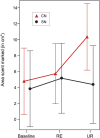Communal breeding affects offspring behaviours associated with a competitive social environment
- PMID: 30443002
- PMCID: PMC6237865
- DOI: 10.1038/s41598-018-35089-w
Communal breeding affects offspring behaviours associated with a competitive social environment
Abstract
Communal breeding is characterised by shared care of offspring produced by more than one female, and can affect the behavioural development of young. The decision to care communally can vary according to local conditions, and has been hypothesised to occur more frequently when social competition is intense. However, it is unknown whether communal rearing of young influences adult behaviours likely to be adaptive under competitive conditions. Here, using a controlled experimental approach, we investigate effects of communal rearing on competitive and exploratory behaviours of adult male house mice. In tests of competitive scent marking, only communally-reared subjects discriminated between related and unrelated rivals, depositing more scent marks in close proximity to unrelated males. Communally-reared subjects also displayed higher exploratory tendencies, with an increased probability of crossing a water barrier, while not exhibiting higher activity levels in an open field test. Since exploration tendencies and discrimination between kin and non-kin are likely to be advantageous when dispersing from the natal territory or in a high density population, our findings suggest that communal rearing prepares male house mice for a competitive social environment. Our results add to growing evidence that the early social environment influences development of important behavioural competences to cope with social challenges later in life.
Conflict of interest statement
The authors declare no competing interests.
Figures


Similar articles
-
Early life social complexity shapes adult neural processing in the communal spiny mouse Acomys cahirinus.Psychopharmacology (Berl). 2025 May;242(5):1025-1040. doi: 10.1007/s00213-023-06513-5. Epub 2023 Dec 6. Psychopharmacology (Berl). 2025. PMID: 38055059
-
Fitness Costs of Female Competition Linked to Resource Defense and Relatedness of Competitors.Am Nat. 2023 Feb;201(2):256-268. doi: 10.1086/722513. Epub 2022 Dec 15. Am Nat. 2023. PMID: 36724459
-
Cryptic kin discrimination during communal lactation in mice favours cooperation between relatives.Commun Biol. 2023 Jul 15;6(1):734. doi: 10.1038/s42003-023-05115-3. Commun Biol. 2023. PMID: 37454193 Free PMC article.
-
Immunocompetence of breeding females is sensitive to cortisol levels but not to communal rearing in the degu (Octodon degus).Physiol Behav. 2015 Mar 1;140:61-70. doi: 10.1016/j.physbeh.2014.12.028. Epub 2014 Dec 12. Physiol Behav. 2015. PMID: 25497887
-
The mouse communal nest: investigating the epigenetic influences of the early social environment on brain and behavior development.Neurosci Biobehav Rev. 2009 Apr;33(4):551-9. doi: 10.1016/j.neubiorev.2008.03.011. Epub 2008 Apr 4. Neurosci Biobehav Rev. 2009. PMID: 18471879 Review.
Cited by
-
Early life social complexity shapes adult neural processing in the communal spiny mouse Acomys cahirinus.Psychopharmacology (Berl). 2025 May;242(5):1025-1040. doi: 10.1007/s00213-023-06513-5. Epub 2023 Dec 6. Psychopharmacology (Berl). 2025. PMID: 38055059
References
-
- Taborsky, B. Developmental plasticity: preparing for life in a complex world, eds Marc Naguib et al. in Advances in the Study of Behavior. 49–99 (Academic Press, 2017).
Publication types
MeSH terms
Substances
LinkOut - more resources
Full Text Sources

